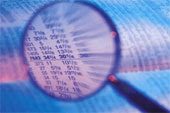 Reader Lou posed this question to get a better handle on ETF selections:
Reader Lou posed this question to get a better handle on ETF selections:
When two or three ETF’s you have been following are above the trend line equally how do you distinguish between them and which to buy?
I look at the M-Index ranking in the StatSheet first to determine any differences in upward momentum. Assuming they’re the same, I quickly glance at the 4-week column, which in most cases shows a difference in performance.
I tend to go with the ETF that has a higher number here, because it more accurately reflects current conditions as opposed to the M-Index number, which takes into account a larger time span.
If that is a close call too, I look at volume. I have discussed its importance many times; the higher the volume the better, as bid/ask spreads are smaller and higher liquidity makes it a snap to get into or out of positions without slippage. This is especially important when the markets correct, your sell stop gets triggered and you want to move to the sidelines in a hurry.
Last not least, if all of the above are the same for two ETFs, I take a look at the expense ratio. Maybe you can save a few dollars here but, when using trend tracking, this is really not as important as for a buy and holder, since we’re only exposed to this ETF for a limited time frame.
I also consult the figures in the MaxDD% column, which is explained in the glossary section of the StatSheet, however, due to lack of space, these number are not featured anywhere. I talked about them in more detail in “Using The Benefit Of Hindsight.”
Using the above suggestions may not always produce a top performer, but I believe that these ideas will improve your selections rather than not using any method or screening process at all.
